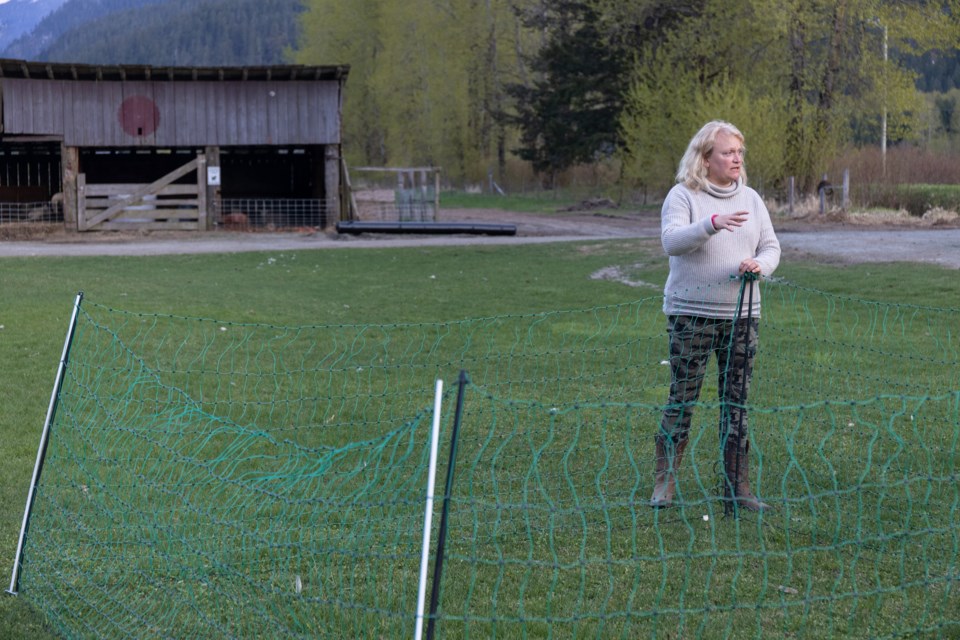As bear season in the Sea to Sky ramps up, the importance of securing wildlife attractants like garbage, recycling, fruit trees and bird feeders around your home is reiterated often.
But what do you do when your home is located on agricultural land with fields full of wildlife attractants?
That was one topic addressed in a series of spring grizzly bear safety and coexistence workshops held in Pemberton last week, led by Gillian Sanders, a Kootenays-based coordinator with Grizzly Bear Coexistence Solutions, and co-presented by the Coast to Cascades Grizzly Bear Initiative (C2C) and the Grizzly Bear Foundation (GBF).
Though grizzly sightings remain relatively rare in the valley, Pemberton sits at the habitat fracture of two threatened and recovering grizzly bear populations: the Squamish-Lillooet and South Chilcotin population units, estimated to include 46 bears and 222 bears, respectively.
“One of the most important ways we can keep people and bears safe is by preventing bears from accessing attractants around our homes, farms, and communities,” explained Jolene Patrick, coexistence and education coordinator with C2C, in a release. “This includes not storing garbage outside, cleaning our barbecues, and taking down bird feeders when bears are active. In farm country, as in Pemberton Meadows, this also means protecting crops, fruit trees, honey bees, and livestock, to allow bears to pass through the valley safely, avoiding encounters with people.”
For many property owners in the Pemberton area, an answer can be found in properly designed and maintained electric fences, explained Sanders.
“All the materials are manufactured and sold for [the purpose of fencing livestock]—we’re using those tools in a specialized design to deter bears,” explained Sanders, who estimates she has installed close to 500 bear-specific fences. “Sometimes people think or are told, ‘Put up an electric fence for bears,’ and they might go and put up a design that would be quite effective for cattle or horses, but completely ineffective for bears.”
The main difference in fence design is the number and the spacing of wires, said Sanders, since bears’ thick fur can often work to insulate the animals from the shock. “You could have very high voltage in that wire, but if it doesn't reach the skin of the animal, it's not going to deliver a shock and it won't keep them away,” noted Sanders.
She generally recommends five to seven wires, spaced about 20 centimetres apart. As far as cost, an electric fence could protect an average-sized chicken coop from bears for about $500. Plus, “there's really no known safety hazard with a well-installed fence,” Sanders said.
In addition to the workshops, Sanders and her fellow grizzly advocates conducted outreach with farmers in the Pemberton Meadows area. “That seemed really positively received and hopefully we'll be having some electric fencing going up in the near future,” said Sanders.
The specially designed fences will also work just as effectively to deter the more commonly spotted black bears, even if the two species tend to behave differently.
“Grizzly bears evolved more on open habitats, and behaviourally perhaps, evolved more to stand their ground when faced with a threat. Black bears evolved more in treed habitats and evolved to flee to the safety of the forest and climb a tree if threatened,” explained Sanders. “One of the differences is that people maybe sometimes yell at a grizzly bear and expect it to leave, and it might not leave, or it might not leave at a run—they might just walk away slowly, but it's still leaving. Personally, I live in an area where there's grizzly bears who come through my property fairly frequently, and I find them incredibly polite neighbours. It's really a matter of making sure they don't find food near us, so they don’t learn to hang around too close.”
C2C and GBF are currently working to launch an electric fencing cost share program, “to support farmers with their coexistence efforts in key grizzly bear connectivity areas,” according to the release.
For the many Sea to Sky residents who may be more likely to encounter a grizzly in the backcountry than on their property, Sanders advises always carrying bear spray in an easily accessible location, and knowing how to use it. Those in attendance at the grizzly bear safety workshop, held at the Pemberton Library on April 27, had the chance to practice with inert bear spray during the event. Sanders also advises avoiding using headphones or ear buds while in the backcountry, reading up on bear behaviour and properly securing any food or attractants while camping.
“Bears really go out of their way to coexist [with us], and so I think we can meet them part way by making sure we're not attracting that to our campsite,” she said.




